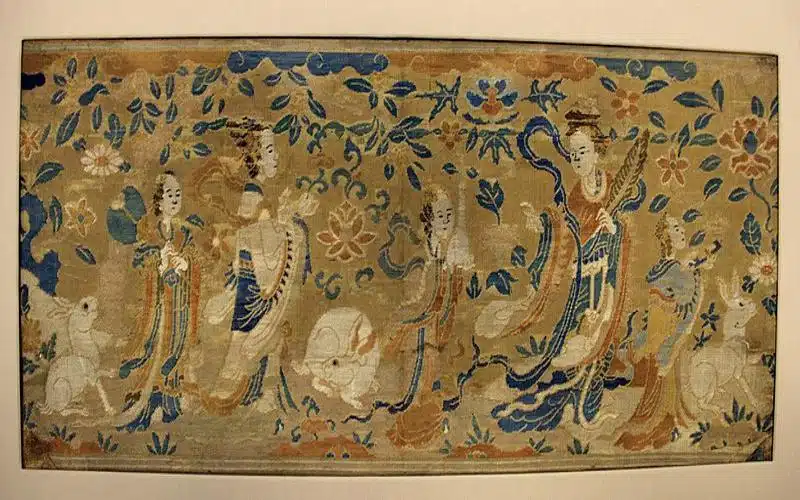Originally Heng’e, Chang’e is the Chinese goddess of the moon. Many Chinese tales and legends talk about this goddess, and her significance didn’t fade over the many centuries.
Her story is truly unique, and it carries several strong messages. For that reason, the cult of Chang’e is still going strong. So, if you want to learn what’s so appealing and special about this goddess, keep reading!
Chang’e’s Origin Story: Betrayal of Hou Yi

There are several versions of Chang’e’s origin story, but they all have some similar elements. In all versions, Chang’e is married to Hou Yi, a powerful archer that somehow got a hold of an immortality elixir.
Hou Yi and His Feat
In some versions of their story, Hou Yi was a god of archery. Some other versions claim he was half-divine, and others claim he was a mere mortal. In either case, Hou Yi got an unusual task from a mythical king Yao.
During that time, the Earth had not one but ten suns. These ten suns would pass the sky one by one, but one day, all ten suns appeared in the sky at the same time. This, of course, made life on Earth practically unbearable.
King Yao summoned Hou Yi because Hou Yi was already famous for his archery and warrior skills. The king tasked him to get rid of so many suns by any means necessary. At first, Hou Yi tried to be diplomatic.
When he saw that his persuasion skills weren’t strong enough, he pretended to shoot arrows from his mighty bow, but that didn’t work either. Finally, he started actually shooting at the suns, one by one.
His blows were more than effective, and suns started falling on the Earth, transforming into three-legged ravens. Finally, only one sun was left in the sky, and people could finally go back to their normal lives.
As a reward for his heroic feat, Hou Yi received one or two elixirs of immortality. He urgently returned back to his wife Chang’e and gave her elixirs before he went on to another adventure. His plan was to consume these elixirs along with his wife and continue his life as an immortal being. However, his plan never came to fruition.
Stolen Immortality
In the first version of the story, Hou Yi left his elixirs with Chang’e and went hunting. Somehow, the word about the elixirs got out, and Hou Yi’s apprentice Fengmeng broke into their home. Fengmeng tried to force Chang’e to give him the elixir.
Cornered and helpless, Chang’e consumed both elixirs to prevent Fengmeng from taking them for himself. Then, as an immortal being, she ascended past the heavens and chose to settle on the moon because she wanted to stay close to her husband as much as possible.
When Hou Yi came back home and found out what had happened, he was desperate. He felt guilty for putting Chang’e in such a situation, and he also realized that he had lost both his wife and his chance for immortality. He displayed Chang’e favorite fruits and cakes and then killed himself.
In another version of this story, Chang’e actually stole the elixirs from her husband and drank them. Some sources say Hou Yi was already too powerful and cruel, so Chang’e stole the elixir to prevent him from gaining absolute power.
Some other sources claim that she wanted immortality for herself only, and she didn’t want to share it with her husband. In both variations, Hou Yi was disappointed by his wife’s betrayal and a missed opportunity for immortality.
He decided at least to pass his skills and knowledge to new generations when he couldn’t become immortal. One of his disciples was Fengmeng, and even though he learned so much from Hou Yi, he could never come even close to his mentor.
Full of envy, Fengmeng made several unsuccessful attempts at Hou Yi’s life. Finally, he managed to bludgeon his teacher with a peach tree.
Other Chang’e Stories
Apart from her role in the story of stolen immortality elixirs, Chang’e appeared in several other tales. She served the Jade Emperor until one day when she accidentally broke a prized porcelain pot. As a punishment, Emperor condemned her to live as a mortal. She served her sentence until one day when her husband brought immortality elixirs…
There is another story that took place when Chang’e was already the moon goddess. Zhu Baijie, a commander of the Jade Emperor’s naval forces, tried to flirt with Chang’e during one particularly cloudless night. As a punishment, he transformed into a pig demon and went to delve into the mortal realm.
Chang’e’s Role In Chinese Religion
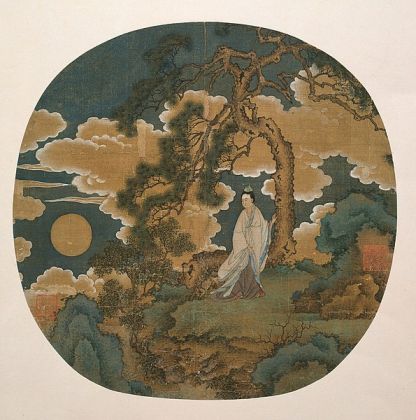
As a lunar goddess, Chang’e is also the goddess of fertility and the protector of women, pregnancy, children, and childbirth. As I already said, her influence is still strong among the Chinese people.
Mid-Autumn Festival
Her cult is still alive today, and it is the basis for Mid-Autumn Festival. In terms of popularity and significance, this festival is a close second to the Chinese New Year, which speaks enough.
Mid-Autumn Festival dates back to at least 3000 years ago. It happens on the 15th day of the 8th month of the Chinese lunisolar calendar, with a full moon at night. This corresponds to mid-September to early October of the Gregorian calendar.
According to Chinese culture and mythology, this day is the day when the moon is brightest and fullest, which also coincides with the harvest season. With that in mind, it is easy to see traces of Chang’e in this festival.
This is the time when people celebrate the reaping of rice and other grains. Depending on the region, people gather in large numbers outdoors, light candles, perform dances, etc.
Rituals for Appeasing Chang’e
During the Mid-Autumn festival, there are several rituals that people perform in order to appease and worship Chang’e, as well as to celebrate the harvest.
Mooncakes
One of those rituals and traditions is definitely preparing and eating mooncakes. Mooncakes, as their name suggests, are rounded cakes. By definition, a mooncake is a rich pastry cake filled with red bean paste, mixed nuts, or other fillings.
Oftentimes, mooncakes contain a duck egg yolk in the middle, which symbolizes the full moon. The pastry skin is thick, and each cake has an imprint on its top. These imprints usually contain Chinese characters for longevity and harmony.
Apart from these characters, mooncakes often feature imprints of the moon, Chang’e, flowers, vines, leaves, rabbits, and other symbols of fertility and the moon. This is my theory, but these mooncakes are evocative of the time when Hou Yi, saddened by his wife’s disappearance, made cakes and fruits in her honor.
Lanterns and Other Rituals
During this festival, people are also carrying and displaying numerous lanterns of different shapes and sizes. These lanterns are symbolic beacons of hope and prosperity for Chinese people. People also burn incense as an act of goddess Chang’e worship. There are also lion and dragon dance performances, especially in South China.
Apart from mooncakes, there are also other food offerings and displays. Fruits like peaches, pears, apples, grapes, pomegranates, and watermelons are only some of the fruits on display.
This festival is also the time to celebrate love and marriage, and it is also a popular matchmaking opportunity. People organize dance parties where young people can meet and possibly start a romance. Young girls are encouraged to throw their handkerchiefs into the crowd, and young men who find them have a chance of dating these girls.
There are also various other games that have strong symbolic meanings. These games may vary strongly between different regions of China or between different ethnic groups. Most of these games have strong symbolic connections to Chang’e’s story.
It is also important to note that not only these games but also all other rituals may vary from region to region. China is a diverse and large country with many ethnic groups. It is not surprising that every region and ethnic group has its own variation of Mid-Autumn Festival activities.
They still have one thing in common – celebrating the harvest, fertility, life, abundance, and of course, our goddess Chang’e.
The Emotional and Spiritual Symbolism of Chang’e’s Story
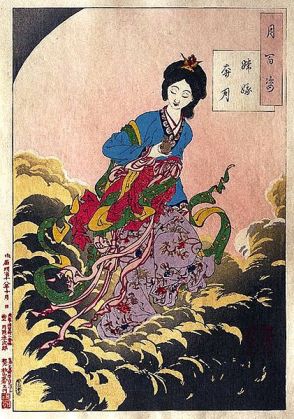
At first glance, Chang’e’s story is a story of betrayal. However, it is much more complex than just a woman stealing and betraying her husband. It is the story of liberation.
Being Alone and Happy
By drinking the immortality elixir alone, Chang’e chooses to live independently and free from the influence of male figures in her life. She spends the rest of her life alone, perfectly content that way. This is a great reminder that while having a good partner certainly makes your life better, being alone is not the end of the world.
After all, to be truly happy, we need to be able to be independent. You are only happy if you can also be happy alone. As long as our happiness depends on others, especially on male romantic partners, we will always be in danger of this happiness being taken away from us. When you learn to be happy alone, no one can take it away from you.
Opposing Patriarchy
In all versions of her story with immortality elixirs, Chang’e opposes a male figure and ascends to the heavens. This doesn’t mean that women should oppose men at every cost. However, dismantling the patriarchy and doing what we want instead of what men want us to do is key to our happiness.
For so many centuries, a woman’s role was to serve men in her life. Even today, when things are much better, misogyny is still going strong, especially in the patriarchal society. Hopefully, one day, all women will be able to finally live their lives as they want, not as men want them to.
Fertility and Femininity
Chang’e didn’t choose to go to the moon by accident. This celestial body has been a symbol of fertility and femininity since the dawn of human civilization across many cultures and religions.
I already discussed the reasons in some of the previous goddess articles. In short, the moon and its phases are connected to women’s menstrual cycle. In general, it takes the same time for the moon to go through all of its phases and for a woman to go through one menstrual cycle.
Also, the moon’s phases symbolize the circle of life and death. When the moon is full and at its brightest, it symbolizes the abundance and richness of life. Then, this full moon gets replaced by a barely visible new moon, which is a symbol of death and also the symbol of change from a bountiful harvest to cold and bare winter.
By choosing to go to the moon, Chang’e also chose to embrace her femininity and fertility. She turned her back on men in her life and became a protector of women, childbirth, and fertility.
As a general society, people always value masculine energy more than feminine. Feminine energy is often seen as weak and submissive, while masculine energy is seen as strong and dominant.
However, without feminine energy, there would be no life. When masculine energy destroys everything through aggression, violence, and wars, feminine energy gives birth to new life and ensures that not everything is lost.
Chang’e’s Relationship to Other Chinese Goddesses
Chang’e is often confused with another Chinese lunar deity, Changxi. Changxi is a lesser lunar deity, and she gave birth to twelve moons. There are some claims that Changxi is Chang’e daughter.
Another goddess that’s indirectly connected to Chang’e is Xihe. Xihe is a Chinese solar deity, and she is the mother of the ten suns that Chang’e’s husband had to take down. Xihe and Chang’e, the sun and the moon, are the two most important celestial bodies for us mortals.
Chang’e’s Appearance and Depiction
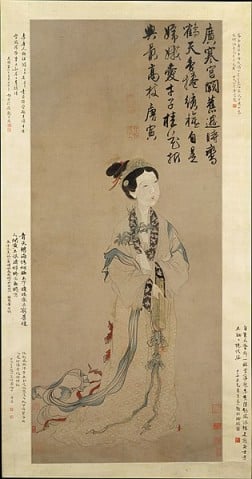
Most sources describe Chang’e as a very beautiful woman. Her hair was black, long, and smooth. Her skin was soft and fair, and he lips were red like cherries. In short, her beauty before ascending to the moon was otherworldly.
Once she ascended to the moon, Chang’e was often depicted surrounded by clouds and wearing white or blue robes. She often held a rabbit in her hands since this animal is closely connected to fertility and, in Chinese mythology, to the moon.
Sometimes, instead of the white rabbit, Chang’e can be seen alongside a Jade Rabbit. Jade Rabbit, also known as the Moon Rabbit, is an important figure in several East Asian religions and mythologies, including the Chinese.
In Chinese mythology, this rabbit is Chang’e’s loyal companion. Furthermore, in some versions of Chang’e’s origin story, the jade rabbit is the one that made the immortality elixir that Chang’e took.
Chang’e And Her Christian Renditions
Just like with other Asian religions, Chinese beliefs are in no way similar to Christianity and other Abrahamic religions. That’s why it is so hard to draw a parallel between Chang’e and any Christian female saints.
However, since she is the goddess of the moon and, by extension, the protector of women, fertility, children, and childbirth, we can compare Chang’e with Christian saints of similar attributes.
From that perspective, Christian saints such as St. Gerard (the protector of fertility), St. Agnes (patron saint of childbirth and pregnancy), and the Virgin Mary (a universal motherly figure often invoked by mothers and other women, can be considered some sort of Christian versions of Chang’e.
Chang’e-Like Goddesses From All Around The World
When it comes to other cultures, there are many moon goddesses that are similar to Chang’e. Some of them are Coyolxauhqui, Maya, Artemis, Diana, Hecate, Phoebe, Selene, and many others.
All these goddesses have one thing in common: they all rule over the moon, fertility, and the cycle of life. I find it fascinating that so many cultures, completely separated from one another, believed in similar things.
If you want to get in touch with your femininity and improve your fertility, connecting with one (or all) of these goddesses is certainly a move in the right direction.
Legacy
As I already said, Chang’e is still an important figure in Chinese culture, tradition, and religion. Millions of people still celebrate her, especially during the Mid-Autumn festival. Given that this festival is the second most important Chinese holiday, it is easy to see the significance of Chang’e for Chinese people.
Additionally, since the last century was the age of conquering the Moon, Chang’e was a recurring symbol for many people. For example, she was mentioned in a conversation between Houston CAPCOM and the Apollo 11 crew right before the first moon landing,
One impact crater on the Moon was named after Chang’e. Finally, in 2007, the first Chinese lunar mission named its robotic probe spacecraft Chang’e 1. In 2010, there was Chang’e 2, and in 2013, Chang’e 3 finally landed on the Moon. This made China the third country in the world that achieve this, with the first two being the United States and the Soviet Union.
Apart from these extraordinary examples of Chang’e’s legacy, she is also a valuable lesson to modern women. She teaches us to strive for greatness and never to allow a man to prevent us from reaching our full potential.
Symbols
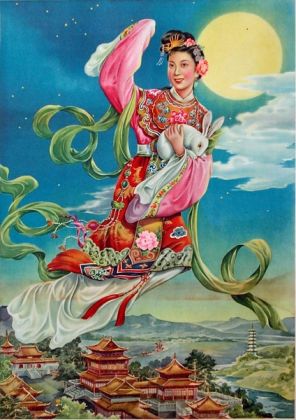
As expected, Chang’e’s symbols are closely connected to her story of moon ascension. Since she is also the goddess of fertility and harvest, symbols associated with those concepts can also serve as Chang’e’s symbols. Let’s take a closer look at these symbols:
General
Of course, the main symbol of Chang’e is the moon itself. This celestial body symbolizes fertility, the cycle of life and death, and (re)birth. After she ascended to the heavens, Chang’e decided to settle on the moon, and since then, it has become her main symbol.
Animals
White rabbits symbolize Chang’e because, in Chinese culture, they symbolize the moon. Additionally, Chang’e is often depicted alongside a rabbit, which is another reason why this is a perfect animal symbol for her.
Some other animals that you can use as Chang’e’s symbols are animals associated with fertility, such as cows, pigs, bees, and frogs.
Plants
In some of her depictions, Chang’e is carrying a lotus flower in her hand, which is a symbol of fertility and femininity. Lotus plant roots are also often displayed as offerings during the Mid-Autumn Festival, which further underlines this plant’s connection to Chang’e.
Perfumes/Scents
One of the ways to worship and appease Chang’e is to burn incense in her honor. This is why incense is one of the best scent symbols of Chang’e. Some other scents and perfumes that symbolize fertility and femininity, such as rose, musk, vanilla, etc., are also great alternatives to incense.
Gems and Metals
Silver is a precious metal closely associated with the Moon, and as such, it is a perfect symbol for Chang’e. Other metals and gemstones that are also great symbols of Chang’e are moonstones, pearls, amethyst, and aquamarine.
Goddess Jewelry
There are many great reasons why you might want to keep a healing crystal or stone close to you. That they can look great as jewelry only makes it so much better!
Here is a guide to crystal jewelry you hopefully will find helpful. In it is a list of 30+ crystals and links to some really great looking jewelry with that crystal or stone. Enjoy!
Colors
White, gray, light blue, baby pink, and similar pastel colors are perfect as symbols for Chang’e. They are feminine and gentle, and they reflect the subtle yet captivating beauty of the moon.
Meditations
- Goddess of the moon, shine your light upon me.
- Make me as strong and independent as you are, oh mighty Chang’e.
- Help me ascend to higher levels and reach my full potential.
- Don’t let anyone prevent me from becoming the best version of myself.
- Guide me through the night and dark periods of my life. Be my protection and my ray of light.
- Make me fertile and bountiful just like you are, Chang’e.
- With your guidance Chang’e, I will explore my femininity and fully embrace it.
Want To Bring More Chang’e Qualities Into Your Life?
- Regardless of if you are single or in a relationship/married, try to be independent as much as possible. This doesn’t mean you should push your partner away or never ask for help. It just means that you should be able to survive and thrive even without them.
- If you are in a romantic or any other relationship that’s keeping you down and preventing you from being truly happy – end it. Every relationship should lift both sides up, not bring them down.
- Surround yourself with Chang’e crystals. Wear silver jewelry, dress more femininely, or get a moon tattoo. There are many other options. It doesn’t matter what you choose; each one of these options will bring you closer to Chang’e. The only thing that is important is that you feel comfortable with that option.
- If you live somewhere with a strong Chinese community, you can visit their celebration of the Mid-Autumn Festival. Try a mooncake, light a lantern! If you are not of Chinese or East-Asian descent, try to learn some dos and don’ts of this festival. You don’t want to come across as disrespectful and ignorant.
Featured Image Credit: Metropolitan Museum of Art, CC0, via Wikimedia Commons

